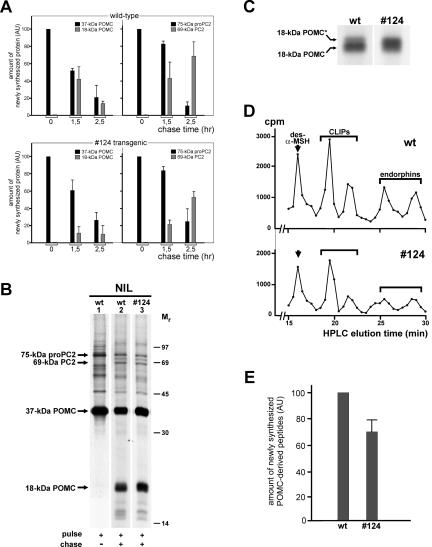Figure 6.
Biosynthesis and processing of newly synthesized POMC and proPC2 in wild-type and transgenic Xenopus intermediate pituitary cells. (A) NILs of black-adapted wild-type (wt) and #124 transgenic animals were pulse labeled for 10 min or pulse labeled for 10 min and chased for 1.5 or 2.5 h. Newly synthesized proteins were extracted from the lobes, resolved by SDS-PAGE directly before (for POMC analysis) or after immunoprecipitation (for PC2 analysis), and visualized by fluorography. The amounts of newly synthesized 37-kDa POMC, 18-kDa POMC cleavage product, 75-kDa proPC2, and 69-kDa mature PC2 were quantified by densitometric scanning and are presented in arbitrary units (AUs), relative to the amount of 37-kDa POMC or of 75-kDa proPC2 produced during the pulse. Shown are the means ± SEM (n = 3, except n = 5 for the 2.5-h chase values). (B) Newly synthesized proteins produced by NILs of black-adapted wild-type (wt) and #124 transgenic animals during a 10-min pulse (lane 1) or during a 10-min pulse/2.5-h chase (lanes 2 and 3) were extracted from the lobes, resolved by SDS-PAGE on 12,5% gels, and visualized by fluorography. (C) Samples corresponding to B, lanes 2 and 3, were reloaded for the separation of newly synthesized 18-kDa POMC and 18-kDa POMC* by SDS-PAGE on 15% gels. (D) Samples corresponding to B, lanes 2 and 3, were subjected to HPLC analysis to separate the newly synthesized POMC-derived peptides des-N-α-acetyl-α-MSH (des-α-MSH), CLIPs, and endorphins. (E) The amounts of the five peptides (des-α-MSH, two CLIPs, and two endorphins) produced in the #124 transgenic cells were calculated on the basis of the HPLC profiles and are presented in AUs, relative to the corresponding peaks in the wild-type profile, showing a 30 ± 11% reduction in the #124 peptide amount (n = 4).

